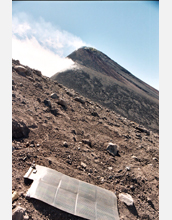Multimedia Gallery
Mini earthquakes provides clues to volcanic behavior (Image 2)
A small explosion from Fuego, an open vent volcano located 20 miles west of Guatemala City. The solar panel seen in the foreground powers a battery that charges a seismometer, which, along with a recording system and power system, is used to collect data. The seismometer records ground shaking motion produced by the volcano or by other sources such as earthquakes. The instruments are buried underground.
Open vent volcanoes constantly pop with small eruptions, which cause low-level, low-frequency earthquakes but usually pose little risk. Scientists are studying these earthquakes to learn more about volcanic behavior and, ultimately, better ways to predict when a major eruption might occur.
Greg Waite, an assistant professor of geological and mining engineering and sciences at Michigan Technological University, is conducting his research on Fuego and Pacaya, another open vent volcano just south of Guatemala City, under a National Science Foundation (NSF) Faculty Early Career Development (CAREER) award. By understanding the behavior of these mini earthquakes, he hopes to collect more details about the behavior of all eruptions, including information about the shape of volcanic plumbing systems and the dynamics that result in eruptions.
"We can apply what we learn about these small, repetitive events to other active volcanoes that are capable of large, damaging eruptions," says Waite. "We are trying to get a better handle on what these little earthquakes mean so we can better forecast major eruptions."
To learn more about Waite's research, see the NSF Discovery story Studying Mini Earthquakes Provides Clues to Volcanic Behavior. [Research supported by NSF's Office of International and Integrative Activities, grant IIA 0530109.] (Date of Image: January 2008 to January 2009) [Image 2 of 4 related images. See Image 3.]
Credit: Greg Waite, Michigan Tech
Images and other media in the National Science Foundation Multimedia Gallery are available for use in print and electronic material by NSF employees, members of the media, university staff, teachers and the general public. All media in the gallery are intended for personal, educational and nonprofit/non-commercial use only.
Images credited to the National Science Foundation, a federal agency, are in the public domain. The images were created by employees of the United States Government as part of their official duties or prepared by contractors as "works for hire" for NSF. You may freely use NSF-credited images and, at your discretion, credit NSF with a "Courtesy: National Science Foundation" notation.
Additional information about general usage can be found in Conditions.
Also Available:
Download the high-resolution JPG version of the image. (1.1 MB)
Use your mouse to right-click (Mac users may need to Ctrl-click) the link above and choose the option that will save the file or target to your computer.



